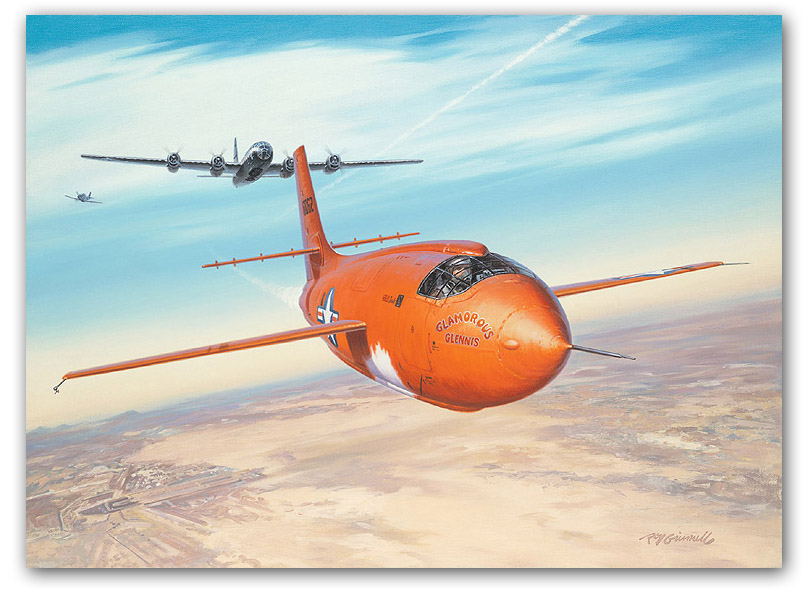

A Special Gold Star for the Ladies.
Posted on 12/08/2003 12:01:01 AM PST by SAMWolf


A Special Gold Star for the Ladies.

|
Air Power |
The diminutive Bell X-1 rocket research plane was the world's first aircraft to break the "sound barrier" and achieve supersonic flight on Oct. 14, 1947, when "Chuck" Yeager's "Glamorous Glennis" passed Mach 1 on its epic flight. The aircraft's conical nose was modeled on the lines of a .50 caliber bullet. While the X-1 was capable of taking off under its own power, all but one of its flights began with a high-altitude drop from a launch aircraft in order to conserve precious rocket fuel.
During World War II, fighter pilots encountered a new and terrifying phenomenon. Rolling over into steep dives, they accelerated to speeds of 500 mph and into the unknown region of transonic flight (0.7-1.3 Mach) where the effects of compressibility--loss of control and structurally devastating aerodynamic loads--began to take over with often deadly consequences. By war's end, new turbojet engines were under development and they promised even higher speeds--speeds passing through the transonic and even, perhaps, into the supersonic region. So little was known about transonic aerodynamics, however, that many aerodynamicists theorized that drag would reach infinity as an airplane approached the speed of sound. The possible existence of a "sound barrier" was only one of a host of unknowns constituting a very real barrier to flight progress. Aircraft designers could not proceed without valid data and the wind tunnels of the day, which "choked" as the airflow around models reached transonic velocities, provided few answers.
Thus an experimental research airplane--the rocket-powered and bullet-shaped Bell X-1 --was designed and built to acquire the necessary data and to determine whether or not a piloted aircraft could actually penetrate the "sonic wall." The X-1 aircraft were almost 31 feet long and had a wingspan of 28 feet. The X-1 was built of conventional aluminum stressed-skin construction to extremely high structural standards. The X-1E was also 31 feet long but had a wingspan of only 22 feet, 10 inches. It was powered by a Reaction Motors, Inc., XLR-8-RM-5, four-chamber rocket engine. As did all X-1 rocket engines, the LR-8-RM-5 engine did not have throttle capability, but instead, depended on ignition of any one chamber or group of chambers to vary speed.
The X-1 was the first in a series of "X"--or experimental--aircraft that were designed to answer fundamental questions, to probe the most challenging unknowns of flight and solve their mysteries. The program was also the Air Force's first foray into experimental flight research and the first collaborative effort in what would become an extraordinarily productive partnership between it and the National Advisory Committee for Aeronautics (NACA). The first NACA contingent arrived at Muroc Army Air Field (later Edwards) in September of 1946 and the NACA and its successor, NASA, have been conducting fundamental flight research there ever since.
There were four versions of the Bell X-1 rocket-powered research aircraft that flew at the NACA High-Speed Flight Research Station, Edwards, California. The bullet-shaped X-1 aircraft were built by Bell Aircraft Corporation, Buffalo, N.Y. for the U.S. Army Air Forces (after 1947, U.S. Air Force) and the National Advisory Committee for Aeronautics (NACA). The X-1 Program was originally designated the XS-1 for EXperimental Supersonic. The X-1’s mission was to investigate the transonic speed range (speeds from just below to just above the speed of sound) and, if possible, to break the "sound barrier." Three different X-1s were built and designated: X-1-1, X-1-2 (later modified to become the X-1E), and X-1-3. The basic X-1 aircraft were flown by a large number of different pilots from 1946 to 1951.
The X-1 Program not only proved that humans could go beyond the speed of sound, it reinforced the understanding that technological barriers could be overcome. The X-1s pioneered many structural and aerodynamic advances including extremely thin, yet extremely strong wing sections; supersonic fuselage configurations; control system requirements; powerplant compatibility; and cockpit environments. The X-1 aircraft were the first transonic-capable aircraft to use an all-moving stabilizer. The flights of the X-1s opened up a new era in aviation.
The X-1 program also represented a turning point. Up until that time, experimental flight research programs had always been flown by contractor or NACA test pilots. Thus it represented a major departure from convention when, after Bell pilots had demonstrated the flight worthiness of the airplane up to a speed of 0.8 Mach, the assault on Mach 1 was turned over to a young Air Force test pilot. The man chosen to make that assault was a 24-year old combat ace named Capt. Charles E. "Chuck" Yeager . What followed is well known. After launch from a B-29 for his ninth powered flight on October 14, 1947, he accelerated to a speed of Mach 1.06 (700 mph) at 42,000 feet and shattered the myth of the sound barrier forever. Though few people could comprehend its full implications at the time, he had just taken the first step in a chain of events that would ultimately vault man beyond the atmosphere and into space.
This achievement also legitimized the role of military test pilots in flight research and, with the flights of the X-1, testing at Muroc began to assume two distinct identities. Highly experimental research programs were typically flown in conjunction with the NACA (later NASA) and conducted in a very methodical fashion to answer largely theoretical questions. Meanwhile, highly accelerated development programs to evaluate the capabilities of aircraft proposed for the operational inventory were conducted by Air Force and contractor test teams.
Even while the original X-1s were still flying, modified versions were being developed to study high-speed aerodynamics. Three second-generation aircraft were built: the X-1A, X-1B and X-1D. The X-1A, X-1B, and the X-1D were growth versions of the X-1. They were almost five feet longer, had an improved rocket propellent system and conventional canopies. The X-1A and X-1B were modified to have ejection seats. Their mission was to continue the X-1 studies at higher speeds and altitudes. All three of the Bell Aircraft Company manufactured planes had a 6,000-lb thrust, XLR-11 four-chambered rocket engine. The XLR-11 was built by Reaction Motors Inc. The aircraft were all air-launched from a carrier aircraft.
The X-1A was larger than its predecessor in order to carry more fuel, carried reliable turbo pumps, and had better cockpit visibility. This aircraft attained a speed of Mach 2.44 and an altitude of 90,440 feet. The X-1A was the first to begin this research after the X-1D was destroyed in an explosion on a captive flight before making any research flights.On December 12, 1953, Maj. Chuck Yeager piloted the X-1A rocket plane to a speed of Mach 2.44 (1,650 mph) in level flight at an altitude of approximately 76,000 feet. As he attained top speed, however, the X-1A tumbled violently out of control. He was encountering something new--something aerodynamicists called "inertia coupling." The airplane tumbled violently--about all three axes--for more than 40,000 feet before Yeager was able to begin to recover to wings-level, stable flight. When landed safely on Rogers Dry Lake he was, once again, the "fastest human alive" but it was quite apparent that there were still many mysteries to be solved concerning supersonic flight. Nine months later, on August 26, 1954, Maj. Arthur "Kit" Murray flew the same aircraft to a new altitude record of 90,440 feet. Those two performances were the records for the X-1 program. On July 20, 1955, the X-1A was lost just before its first NACA test flight when it had to be jettisoned from the launch aircraft following an onboard explosion.
The Bell X-1B was a second-generation X-1 used by the U.S. Air Force for pilot familiarization before being turned over to NACA in December 1954. The X-1B was similar to the Bell X-1A except for the installation of wingtips extensions for its last three flight. The X-1B had a modified fuselage with greater capacity for fuel tanks, an improved cockpit, and a turbopump fuel system as compared with the X-1. The NACA used the X-1B primarily for aerodynamic heating and reaction-control research from 1956 to 1958. The aircraft was fitted with special instrumentation for exploratory aerodynamic heating tests. It had over 300 thermocouples installed on it. The X-1B was the first aircraft to fly with a reaction-control system; a prototype of the reaction-control system used on the X-15 and other piloted test aircraft. . Midway through its flight test program, the X-1B was equipped with an Reaction Motors, Inc. XLR-11-RM-9 engine which differed, from the other XLR-11s, only in having an electric spark, low-tension interrupter type ignition in place of the older high-tension type. The X-1B was given to the Air Force Museum at Wright-Patterson Air Force Base Dayton, Ohio, on January 27, 1959, for preservation and display. This aircraft completed a total of 27 glide and powered flights by eight U.S. Air Force and two NACA test pilots.
The X-1C was cancelled while still in the mock-up stage.
The X-1D had short career, just one flight. On 24 July 1951, its nose gear failed during landing. The X-1D was destroyed in August 1951 after being jettisoned from its B-50 carrier plane, following an explosion.
The number two X-1 was modified and redesignated the X-1E. The modifications included adding a conventional canopy, an ejection seat, a low-pressure fuel system of increased capacity, and a thinner high-speed wing. The X-1E was used to obtain in-flight data at twice the speed of sound, with particular emphasis placed on investigating the improvements achieved with the high-speed wing. These wings, made by Stanley Aircraft, were only 3 - 3/8-in. thick at the thickest point and had 343 gauges installed in them for measurement of structural loads and aerodynamic heating. The X-1E used the XLR-11 rocket engine from the X-1 to power it up to a speed of 1,471 mph and to an altitude of 73,458 ft. Like the X-1 it was air launched.
Specifications:
Primary Function: Experimental Aircraft
Contractor: Bell
Crew: One
Unit Cost: N/A
Powerplant: Reaction Motors, Inc., XLR-11-RM-3 (model A6000C4) four chamber rocket engine, rated at 6,000 lb static thrust
Dimensions:
Length: 30.9 feet
Wingspan: 28 feet
Height: 10.85 feet
Weights: Empty: 7,000 lb / Maximum Takeoff: N/A
Performance :
Speed: mach 1.45 (957mph)
Ceiling: 71,900 feet
Range: N/A
Armaments:
None








All photos Copyright of Global Securtity.org





Hello troops and veterans!
THANK YOU for serving the USA!

Forget? NO WAY!!

Life back to "normal", what ever that is, eh??
Normal? That'll never happen around here. LOL!! Goes against the grain.
But things are muuuuch quieter. Whew! Now if I can just get this last glass panel finished tonight, I'll be cookin' with gas! It's been a stinker, for sure.
Hubby's sitting here impatiently waiting for supper so I guess I'd better take care of that little detail. *giggle* Have a wonderful evening.
Bless both your hearts for todays thread.
Sam, glad you enjoyed the "bushswackling" Master and Commander, it really took one into the guts of sea battles back then.
Disclaimer: Opinions posted on Free Republic are those of the individual posters and do not necessarily represent the opinion of Free Republic or its management. All materials posted herein are protected by copyright law and the exemption for fair use of copyrighted works.